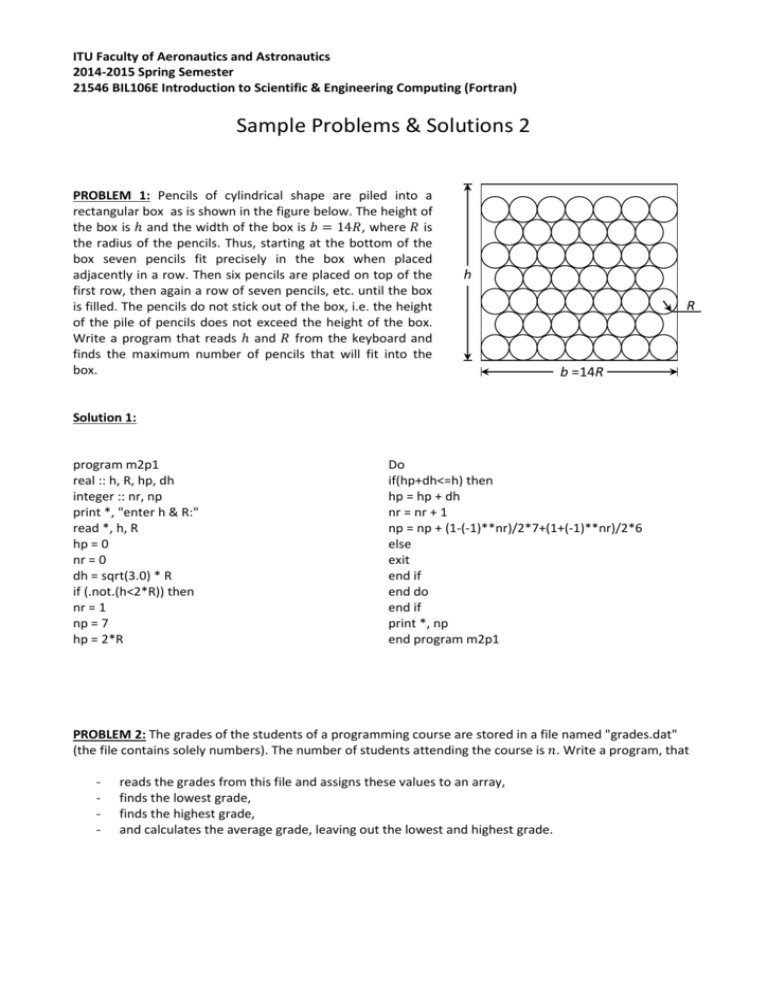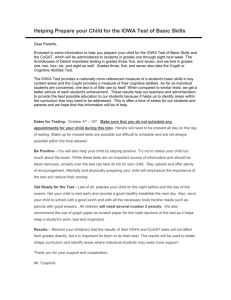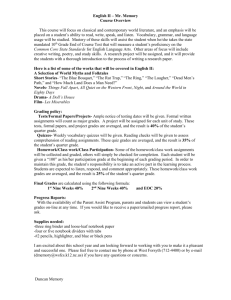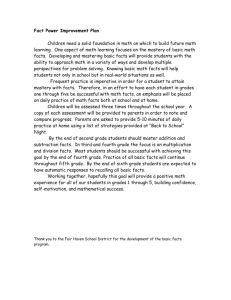Sample 2
advertisement

ITU Faculty of Aeronautics and Astronautics 2014-2015 Spring Semester 21546 BIL106E Introduction to Scientific & Engineering Computing (Fortran) Sample Problems & Solutions 2 PROBLEM 1: Pencils of cylindrical shape are piled into a rectangular box as is shown in the figure below. The height of the box is ℎ and the width of the box is 𝑏 = 14𝑅, where 𝑅 is the radius of the pencils. Thus, starting at the bottom of the box seven pencils fit precisely in the box when placed adjacently in a row. Then six pencils are placed on top of the first row, then again a row of seven pencils, etc. until the box is filled. The pencils do not stick out of the box, i.e. the height of the pile of pencils does not exceed the height of the box. Write a program that reads ℎ and 𝑅 from the keyboard and finds the maximum number of pencils that will fit into the box. h R b =14R Solution 1: program m2p1 real :: h, R, hp, dh integer :: nr, np print *, "enter h & R:" read *, h, R hp = 0 nr = 0 dh = sqrt(3.0) * R if (.not.(h<2*R)) then nr = 1 np = 7 hp = 2*R Do if(hp+dh<=h) then hp = hp + dh nr = nr + 1 np = np + (1-(-1)**nr)/2*7+(1+(-1)**nr)/2*6 else exit end if end do end if print *, np end program m2p1 PROBLEM 2: The grades of the students of a programming course are stored in a file named "grades.dat" (the file contains solely numbers). The number of students attending the course is 𝑛. Write a program, that - reads the grades from this file and assigns these values to an array, finds the lowest grade, finds the highest grade, and calculates the average grade, leaving out the lowest and highest grade. Solution 2: program m2p2 integer :: i, grades(10), ming, maxg, summ real :: ave open (10, file = "grade.txt") do i = 1, 10 read(10, '(i2)') grades(i) end do maxg = grades(1) ; ming = maxg do i = 2, 10 if (grades(i).lt.ming) then ming = grades(i) end if if (grades(i).gt.maxg) then maxg = grades(i) end if end do summ = 0 do i = 1, 10 summ = summ + grades(i) end do ave = real(summ - maxg - ming)/10 print *, ming, maxg, ave end program m2p2 PROBLEM 3: What will be displayed when the following program is run? program p3 integer :: x = 123 real :: y = -4.56 character(len=4 ) :: z = "7890" print '(i2,tr1,f5.2,2x,a4)', x, y, z print '(i3,f4.2,a3)', x, y, z print '(i4,f5.2,tl4,a2)', x, y, z end program p3 Solution 3: **_-4.56__7890 123****789 _123-7856 PROBLEM 4: Write a subroutine that changes the elements of a square-matrix into the element of its transpose. The subroutine must have a single argument. Solution 4: subroutine tp(a) integer, dimension (:,:), intent(inout) :: a integer :: i, j, n, temp n = size(a, 1) do i = 2, n do j = 1, i-1 temp = a(i, j) a(i,j)=a(j,i) a(j,i)=temp end do end do end subroutine tp PROBLEM 5: Consider the module matlib containing the recursive function 𝑓(𝑛) and the driver program that tests this function. module matlib public :: f contains recursive function f(n) result(t) integer, intent(in) :: n real :: t select case(n) case(2:) t = sqrt(2-f(n-1)) case(1) t = sqrt(2.0) end select end function f end module matlib program p4 use matlib print *, f(1) print *, f(2) print *, f(3) print *, f(4) print *, f(5) end program p4 (a) What will be displayed when the program is run? (b) Write the recurrence relation, the function in the module is based on. What is the seed value of this recurrence relation? (c) To which value, do you think, the function will converge when the argument passed to the function goes to infinity (𝑛 → ∞)? Does this limit value depend on the seed value? Solution 5: (a) 1.414214 7.653669E-01 1.111140 9.427935E-01 1.028206 (b) recurrence relation: 𝑓𝑛 = √2 − 𝑓𝑛−1 Seed value : 𝑓1 = √2 (c) lim 𝑓𝑛 = 1 𝑛→∞ For −2 ≤ 𝑓1 ≤ +2 the limit will be 1. Values beyond the boundaries of this interval are not valid.






